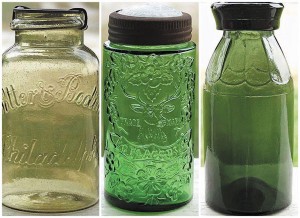The onset of fall means many things to we Hoosiers. Fall festivals, trips to Brown County to view the beautiful foliage, hot apple cider and campfires, and to an ever-growing number of people it means canning season. So, out come the colanders and pressure cookers and most importantly, the Ball canning jars.
Most of us have boxes of canning jars handed down from our Moms and Grandmas. As a result I am often asked, “are they of any value?” Nine times out of ten the answer is, no. BUT, there are exceptions, and those can be worth hundreds of dollars.
While other elements come into play, determining the age of your Ball jars is a good way to start the process of setting their value. Ball mason jars were first produced in 1885 by the Ball Brothers Glass Manufacturing Company, then located in Buffalo, New York. These early issues, known as Buffalo Jars, will have the BBGMC logo. These are among the most rare of all mason jars.
In 1889 the Ball Company relocated to Muncie, Indiana where it produced quality canning jars until 1962. In their many years of production the basic design of the company logo on the front of their jars has remained pretty much the same. But if you look closely, and you know what you are looking for, the key to age is often in the logo.
From 1892-1896 Ball used block lettering. That lettering was changed to cursive in 1897. From 1900-1910 the cursive included a loop at the end of the name Ball which prompted these jars to be given the name “3-loop.” That was altered to a clean line at the end of the name from 1910-1923 which, for obvious reasons, gave jars from this era the nickname “2-loop.”
Through most years of production you will notice that the company name is underscored. The exception to this will be on jars made from 1923-1933. On jars from 1933-1962 there are three defining features; the underscore returned, the “a” is smaller than the other letters and there is a “loop” in the center of the “B”. This is an important fact as pre-1933 jars are the of the ones of greatest interest to collectors.
Descriptive words have been included on some jars through the years. Words to watch for include; Special 1910-1913, Perfect 1913-1922, Ideal 1915-1962, Square (used on the 1925 square jars) and Eclipse which is found on wide-mouth jars from 1926-1952. You will also find upside-down jars by Ball, manufactured from 1900-1910, that were made to double as a coffee grinder dispenser.
Through the years of production jars have found their way into circulation with errors, the most common being the misspelling of the word. “Perfect”. Jars have been found with the spellings “perffct, peprect and perefct”. These jars are of higher value than their correctly printed counterparts.
The majority of Ball jars in circulation are post-1940 clear or aquamarine. There are millions of these out there and their lack of rarity makes them worth $1-$3 each. Be on the look out for rare colors including; cobalt, green, milk glass and black as they will be of greater value. Until next time…Linda.
{Linda Kennett is a professional liquidation consultant specializing in down-sizing for seniors and the liquidation of estates and may be reached at lkennett@indy.rr.com or 317-258-7835}



